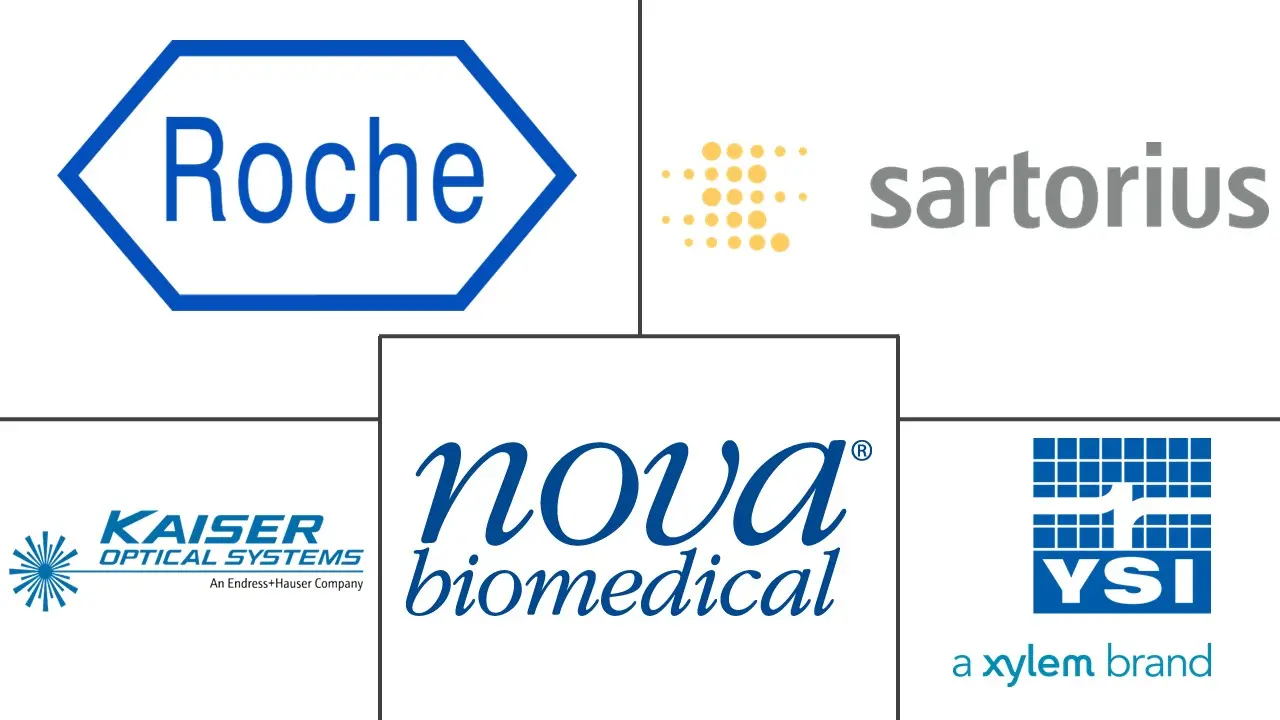Bioprocess Analyzers Market Size and Share
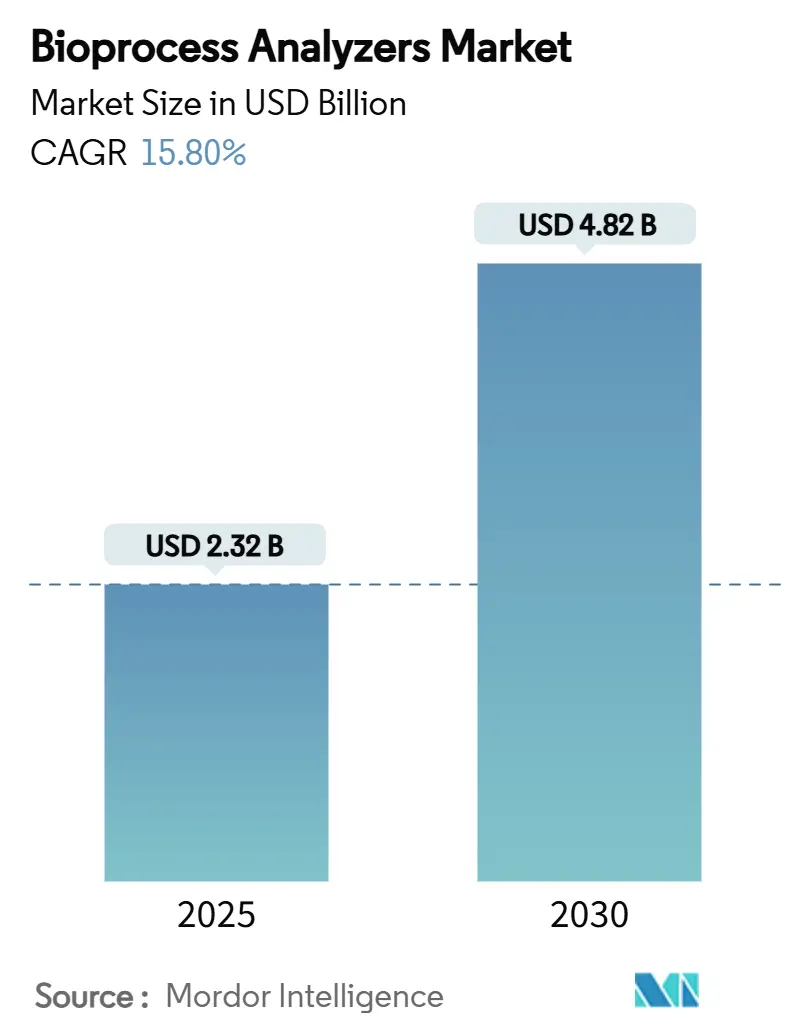
Bioprocess Analyzers Market Analysis by Mordor Intelligence
The bioprocess analyzers market size stood at USD 2.32 billion in 2025 and is set to reach USD 4.82 billion by 2030, translating into a 15.81% CAGR over the forecast period. Demand accelerates as manufacturers abandon retrospective batch testing in favor of real-time optimization, spurred by regulatory preference for continuous manufacturing and the pandemic-era proof of concept delivered during rapid COVID-19 vaccine scale-up. Growth links directly to expanded global biomanufacturing capacity, aggressive investment in single-use technology, and the maturing digital-twin ecosystem that fuses spectroscopy with AI-driven models for predictive quality control. Instruments remain the backbone of monitoring workflows, yet software and analytics capture disproportionate incremental dollars as factories deploy closed-loop control strategies. Regionally, North America retains a dominant installed base, while Asia-Pacific’s surge in green-field plants drives the highest incremental volume. M&A continues at a measured pace, with leading suppliers consolidating to offer vertically integrated hardware-software-service stacks that help end-users navigate validation, data integrity, and workforce shortages.
Key Report Takeaways
- By product category, instruments led with 58.54% revenue share in 2024; software and analytics are projected to expand at a 17.65% CAGR to 2030.
- By measurement principle, Raman spectroscopy secured 42.45% of the bioprocess analyzers market share in 2024, while mass spectrometry records the highest projected CAGR at 17.94% through 2030.
- By type, substrate analysis accounted for 46.67% share of the bioprocess analyzers market size in 2024 and physicochemical parameter monitoring is advancing at a 17.88% CAGR through 2030.
- By application, vaccines captured 33.56% share in 2024 and biosimilars are forecast to grow at an 18.99% CAGR to 2030.
- By end-user, biopharmaceutical companies held 58.97% revenue share in 2024, whereas contract manufacturers are poised for an 18.67% CAGR through 2030.
- By geography, North America commanded 40.32% share in 2024; Asia-Pacific is on track for a 16.54% CAGR to 2030.
Global Bioprocess Analyzers Market Trends and Insights
Driver Impact Analysis
| Driver | % Impact on CAGR Forecast | Geographic Relevance | Impact Timeline |
|---|---|---|---|
| Growth of biopharmaceutical manufacturing capacity | +3.2% | Global; North America & Asia-Pacific hubs | Medium term (2-4 years) |
| Rising adoption of process analytical technology (PAT) | +2.8% | North America & EU leading; APAC accelerating | Short term (≤2 years) |
| Increasing R&D expenditure in life sciences | +2.1% | Global; emphasis on developed markets | Long term (≥4 years) |
| Surge in demand for personalized medicine | +1.9% | North America & EU core; spillover to APAC | Medium term (2-4 years) |
| Expansion of contract manufacturing organizations (CMOs) | +2.4% | Global; fastest in Asia-Pacific | Short term (≤2 years) |
| Favorable regulatory support for continuous manufacturing | +1.7% | North America & EU | Long term (≥4 years) |
| Source: Mordor Intelligence | |||
Growth of Biopharmaceutical Manufacturing Capacity
Rapid green-field and brown-field expansion pushes global installed capacity above 16.5 million L across more than 1,500 facilities, each new bioreactor requiring its own analytical suite. Samsung Biologics’ Plant 5 alone adds 180,000 L, bringing the campus total to 784,000 L and catalyzing orders for spectroscopy, mass-spectrometry, and electrochemical sensors. Similar momentum is visible in North Carolina, where Fujifilm is building eight additional 20,000 L reactors, creating downstream pull for in-line Raman probes. Developing regions amplify demand because regulators mandate equivalency with ICH-compliant processes, forcing local manufacturers to buy validated systems from global vendors. Larger vessels intensify sample throughput requirements, nudging buyers toward multiplexed solutions that monitor metabolite, nutrient, and physicochemical indicators simultaneously. Collectively these projects raise the bioprocess analyzers market baseline and extend replacement cycles as firms standardize on platform technologies.
Rising Adoption of Process Analytical Technology (PAT)
The FDA’s January 2025 draft guidance endorses real-time release testing, clarifying validation pathways and unfreezing capex that had been on hold. Manufacturers fast-track “Process Analytics 4.0,” integrating Raman, NIR, and MS with machine-learning models that hit R² > 0.9 for glucose, lactate, and IgG prediction in small-scale runs. Digital twins compare live data against mechanistic simulations, enabling feed-rate adjustments within seconds instead of hours. These closed-loop architectures cut deviations and shorten batch-review cycles, providing CFO-level ROI that accelerates budget approvals. Early adopters report 25% reductions in product-release timelines, reinforcing the business case for enterprise-wide roll-outs. Vendors respond by bundling software subscriptions with hardware to lock in long-term annuity revenue and differentiate against low-cost sensor entrants.
Increasing R&D Expenditure in Life Sciences
Global life-sciences R&D outlays are projected to reach USD 516.79 billion in 2024, with biologics capturing the lion’s share. Early-stage pipelines increasingly feature cell, gene, and mRNA modalities that require more nuanced process monitoring than classical monoclonal antibodies. Beckman Coulter’s CytoFLEX mosaic, capable of detecting 80 nm particles, addresses nanoparticle analytics central to gene-therapy vectors. Specialized HPLC methods for in-vitro transcription elevate the need for multi-attribute analytical platforms that correlate upstream RNA quality with downstream potency. R&D groups adopt benchtop mass spectrometry for rapid metabolomics, shortening clone-selection cycles. Collectively, these activities funnel a steady stream of demand into the bioprocess analyzers market well before commercial scale, creating a structural tailwind that extends through the product life cycle.
Surge in Demand for Personalized Medicine
Shift toward patient-specific therapies compresses production runs and raises the premium on flexibility. Automated, modular analyzers that can be redeployed within hours gain traction because production lines must pivot between indications. Decentralized factories—sometimes colocated with hospitals—demand compact systems with remote-operation capability for sites lacking advanced instrumentation staff[1]International Society for Pharmaceutical Engineering, “Decentralized Manufacturing White Paper,” ispe.org. AI engines that self-calibrate to each donor’s cell-growth profile enable tighter process control, fueling double-digit software revenue growth. In gene-modified cell therapy, inline spectroscopy tracks vector copy number and transduction efficiency in real time, improving batch acceptance rates. Suppliers that provide integrated hardware, consumables, and SaaS analytics become strategic partners rather than commodity vendors, deepening switching costs and fortifying recurring revenue.
Restraints Impact Analysis
| Restraints Impact Analysis | (~) % Impact on CAGR Forecast | Geographic Relevance | Impact Timeline |
|---|---|---|---|
| High capital and operating costs | -2.1% | Global; smaller and emerging biotech firms most affected | Short term (≤2 years) |
| Stringent validation and compliance requirements | -1.8% | North America & EU; extending to APAC | Medium term (2-4 years) |
| Shortage of skilled bioprocessing professionals | -1.5% | Global; acute in rapidly expanding APAC markets | Medium term (2-4 years) |
| Data integration and interoperability challenges | -1.3% | Global; multi-site manufacturers | Short–medium term (≤3 years) |
| Source: Mordor Intelligence | |||
High Capital and Operating Costs
An integrated PAT workstation can top USD 100,000, discouraging adoption among seed-stage biotech firms and academic labs[2]bioRxiv, “Cost Analysis of PAT Adoption in Academic Labs,” biorxiv.org. Even when capital is secured, ongoing expenses for reagents, calibration standards, and service contracts erode budgets. Attempts to create DIY or open-hardware solutions lower entry barriers but lack the GMP pedigree required for licensed production. Cost-sensitive buyers delay upgrades, extending the use of legacy off-line assays despite productivity penalties. Vendors counter by offering leasing, pay-per-sample, and cloud-based analytics to smooth cash outflows. Still, sticker shock remains a tangible drag on short-term growth, particularly in regions where grant funding cycles dictate purchasing capacity.
Stringent Validation and Compliance Requirements
Qualification of AI-enabled analyzers is a moving target because adaptive algorithms fall outside classical validation templates[3]Parenteral Drug Association, “Validation of AI Systems in GMP Environments,” pda.org. Sponsors often run dual workflows—traditional assays in parallel with real-time systems—to satisfy auditors, effectively doubling workload and dampening ROI. Divergent regional rules force multinationals to tailor validation packages, prolonging tech-transfer timelines. Skilled compliance engineers are scarce, inflating labor costs and creating project bottlenecks. Vendors are investing in pre-validated libraries and turnkey documentation to accelerate deployment, but uncertainty persists, muting the pace at which the bioprocess analyzers market converts early adopters into mainstream buyers.
Segment Analysis
By Product: Instruments Dominate Despite Software Surge
Hardware remained essential, with the instruments segment contributing 58.54% of 2024 revenue. That share reflects a baseline need for tangible sensors, spectroscopy units, and samplers that physically interact with bioreactors. Demand for single-use compatible probes expands the consumables annuity, particularly where disposable bags represent 85% of upstream workflows. The bioprocess analyzers market size for instruments is projected to scale in tandem with mega-plant roll-outs, but growth rates moderate as installed bases mature in legacy geographies.
Software and analytics, although just 14.1% of 2024 spending, deliver a 17.65% CAGR as factories transition to fully digital twins. AI-enabled platforms extend beyond data logging to predictive maintenance and automatic parameter correction, raising overall equipment effectiveness by double digits. The swelling data footprint encourages cloud-native architectures, driving partnerships between instrument vendors and hyperscale providers. This interplay shifts wallet share toward recurring licenses, reshaping vendor P&L and introducing SaaS valuation multiples into the traditionally hardware-centric bioprocess analyzers industry.
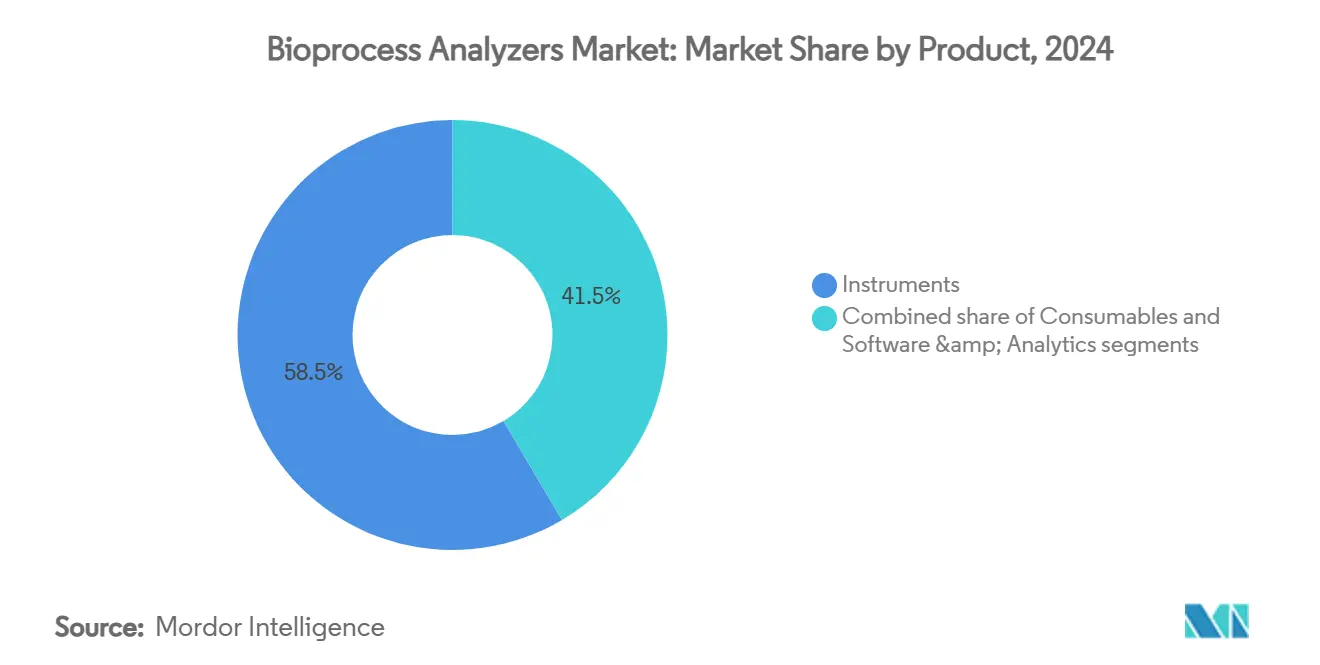
Note: Segment shares of all individual segments available upon report purchase
By Measurement Principle: Raman Leads While Mass Spectrometry Accelerates
Raman spectroscopy captured 42.45% revenue in 2024 by offering non-destructive, water-tolerant insight into metabolite profiles without sample preparation. Inline fiber optics allow continuous tracking of glucose, lactate, and amino-acid pools, underpinning closed-loop nutrient feeds. Model libraries developed in mini-bioreactors transfer seamlessly to manufacturing scale, lowering calibration costs.
Mass spectrometry, however, edges into mainstream acceptance with a 17.94% CAGR. Microfluidic interfaces now permit online sampling at sub-milliliter volumes, enabling real-time titer and impurity maps previously possible only off-line. Vendors emphasize high-resolution, low-maintenance designs to dispel perceptions of complexity. NIR retains traction for biomass estimation, while electrochemical sensors offer low-cost redundancy for critical-quality attributes, rounding out a diversified measurement portfolio that sustains the bioprocess analyzers market.
By Type: Substrate Analysis Dominates Amid Physicochemical Growth
Nutrient availability dictates cell-culture performance, so substrate analysis owned 46.67% market revenue in 2024, tracking variables like glucose, glutamine, and key minerals. High-density perfusion cultures intensify consumption dynamics, renewing demand for multichannel analyzers that monitor substrates alongside waste products. Continuous production elevates the value of concentration detectors that validate steady-state conditions.
Physicochemical monitoring enjoys a 17.88% CAGR, reflecting broader adoption of automated pH, DO, and CO₂ probes linked to plant-wide control systems. As operators pursue real-time release testing, inline confirmation of viscosity and osmolality gains favor. The convergence of substrate, metabolite, and physicochemical data inside unified dashboards reinforces vendor propositions around holistic process visibility, ensuring sustainable expansion of the bioprocess analyzers market size for integrated solutions.
By Application: Vaccines Lead While Biosimilars Surge
Vaccines retained 33.56% of revenue in 2024 thanks to global pandemic-preparedness spending and mRNA platform proliferation. Viral-vector and lipid-nanoparticle processes pose stringent requirements for particle-size, RNA-encapsulation, and potency control, each dependent on high-frequency analyte readings. Regulatory expectations for rapid lot-release further embed real-time analytics.
Biosimilars clock the fastest trajectory at an 18.99% CAGR because demonstrating analytical similarity demands deeper characterization than innovator products. High-resolution mass spectrometry paired with LC techniques forms a multi-attribute method that enables simultaneous monitoring of glycosylation, oxidation, and deamidation. As blockbuster biologics face patent expiry, producers scale capacity in Asia while deploying state-of-the-art analyzers to comply with EMA and FDA comparability guidelines, buoying the bioprocess analyzers market share for advanced instruments.
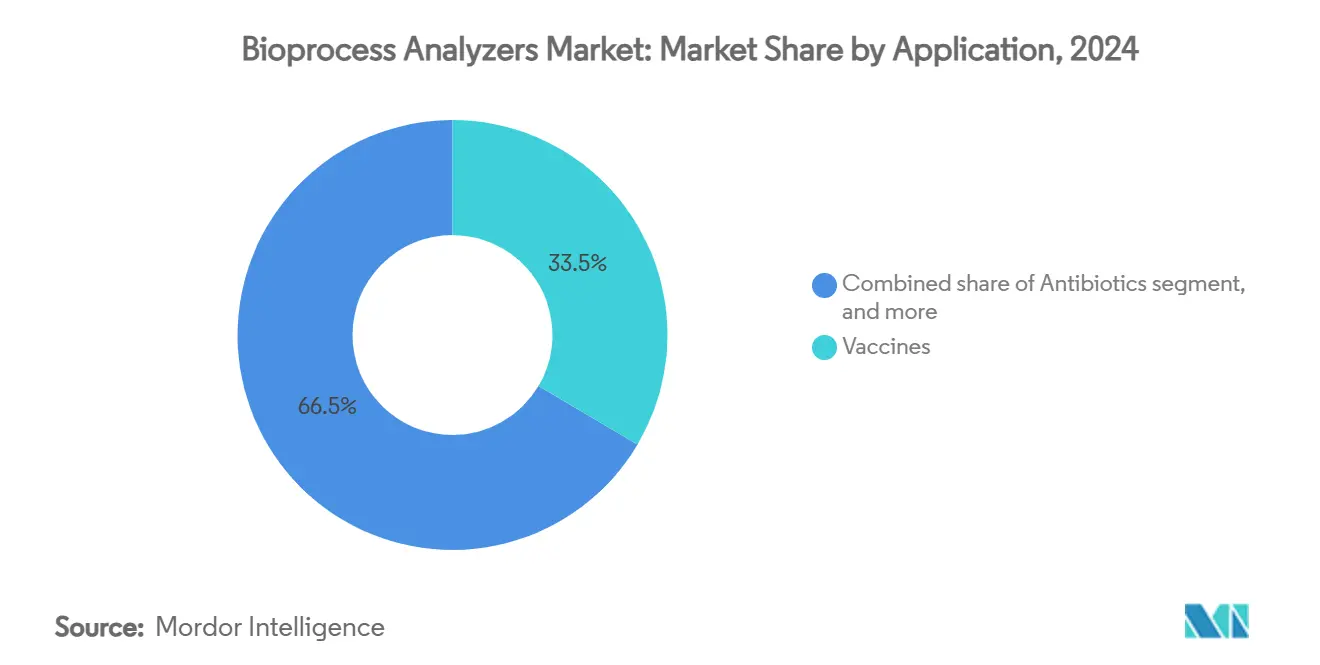
Note: Segment shares of all individual segments available upon report purchase
By End-User: Biopharma Companies Lead CMO Growth
Originator biopharma retained 58.97% revenue share in 2024, reflecting decades of internal manufacturing investment. Even so, internal facilities increasingly resemble commercial CMOs, standardizing on flexible, single-use lines empowered by PAT.
Contract manufacturing and research organizations sprint ahead at an 18.67% CAGR, driven by small biotech outsourcing and big-pharma hedging capacity risk. CMOs operationalize economies of scale in analytical assets by servicing multiple molecules concurrently. Standardized calibration protocols and automated sampling cut changeover to hours, translating instrumentation into revenue faster than in single-product plants. The resulting spending boom provides a diversified revenue stream for vendors, further expanding the global bioprocess analyzers market.
Geography Analysis
North America held 40.32% of 2024 revenue due to a dense concentration of GMP facilities, proactive FDA policy on PAT, and more than USD 160 billion in announced pharmaceutical capex across 2025 projects. Mega-acquisitions such as Lonza’s purchase of Roche’s Vacaville site—housing 330,000 L of reactors—underscore continued maturation of the local supply chain. Meanwhile, draft BIOSECURE legislation could redirect USD 2.1 billion worth of biologics production contracts away from Chinese entities, further stimulating domestic instrument demand. In Canada, government co-investment grants expedite vaccine analytics expansion, offering additional runway for hardware sales.
Asia-Pacific posts a 16.54% CAGR as regional champions execute multi-billion-dollar builds. Samsung Biologics targets 964,000 L of capacity upon completion of Plant 6, generating downstream pull for spectroscopy, chromatography, and data-management systems. Japan’s Five-Year Startup Plan allocates tax incentives for biotech, pushing smaller firms to equip pilot plants with scalable analytics. China’s pursuit of CGMP parity anchors demand for FDA-validated instrumentation, while India’s bioeconomy roadmap pushes indigenous companies to source high-spec measuring tools to tap western outsourcing flows. Southeast Asia emerges as a secondary hub, where CDMOs erect smaller yet sophisticated suites designed to export therapies under stringent ICH standards.
Europe maintains steady, low-double-digit growth underpinned by strong regulatory emphasis on data integrity and single-use innovation, epitomized by Sartorius’ BioPAT Spectro Raman platform. Germany and Switzerland remain pillars for equipment design and application support, while Ireland leverages a skilled workforce and tax regimes to attract U.S. biologics projects. Elsewhere, Middle East & Africa and South America represent nascent opportunities: local governments fund technology-transfer consortia to secure vaccine self-sufficiency, creating pilot orders that seed future adoption. Together these regional dynamics maintain an upward trajectory for the global bioprocess analyzers market.
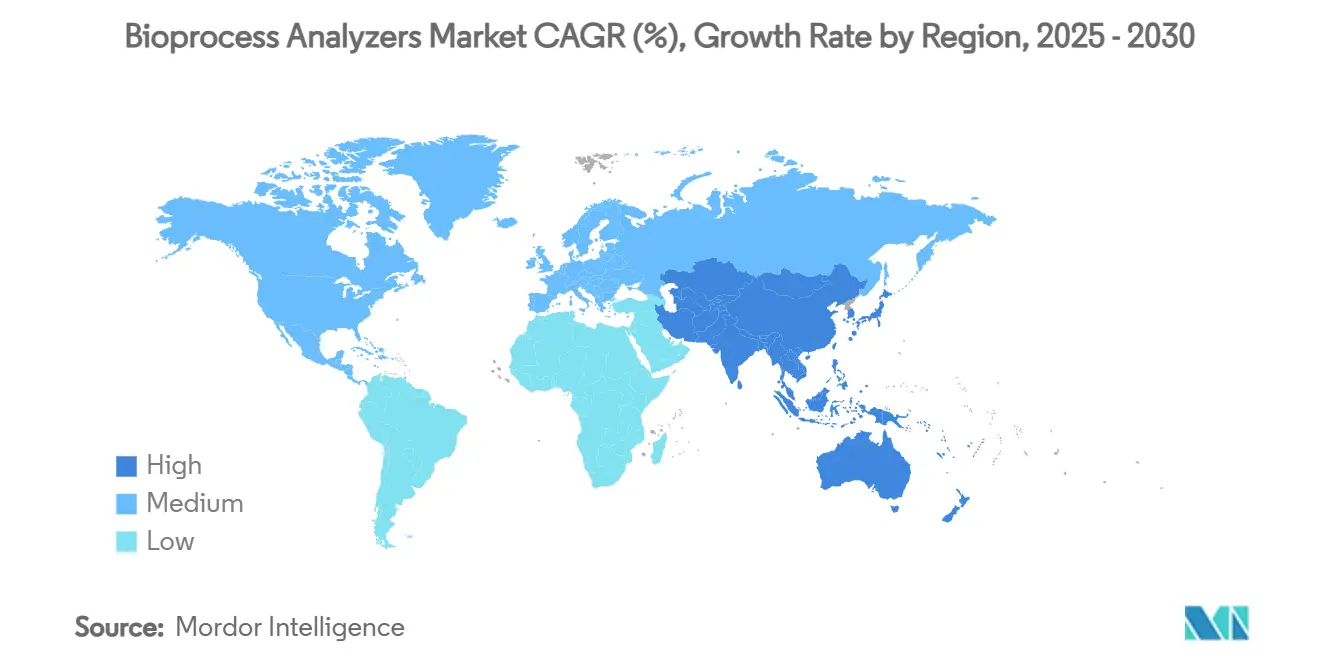
Competitive Landscape
The market shows moderate concentration: no single vendor surpasses a 20% revenue slice, yet the top five collectively exceed 60%, placing the sector at a middle-ground oligopoly. Thermo Fisher enlarges its portfolio via in-house innovation, exemplified by the Stellar mass spectrometer delivering 10× sensitivity gains for bioprocess omics. Agilent’s USD 925 million BIOVECTRA buy expands CDMO analytics reach, integrating small-molecule LC expertise with biologics titer quantification, thereby blurring historical product lines. Sartorius couples hardware with data analytics through BioPAT modules that slot seamlessly into its single-use ecosystem, locking customers into an end-to-end workflow.
Bruker’s acquisition of Optimal Group adds synTQ PAT knowledge-management software, enabling instrument-agnostic data unification that appeals to multi-vendor plants. Advanced Instruments merged with Nova Biomedical to build a USD 621 million revenue platform focused on cell-culture media osmolality and metabolite analyzers, signaling renewed consolidation among mid-tier specialists. Waters emphasizes chromatographic innovations such as BioResolve Protein A columns with MaxPeak surface chemistry for 7× sensitivity enhancements in antibody titer assays.
Competitive differentiation shifts toward software prowess and turnkey validation kits. Vendors race to embed machine-learning engines, remote-support sensors, and on-demand training portals. Intellectual-property filings highlight automated sampling robots and AI-based spectral deconvolution, underscoring a pivot from hardware performance to integrated workflow management. As factories digitize, supplier relationships evolve into multiyear service agreements that bundle upgrades, thereby smoothing revenue cycles and reinforcing the upward momentum of the bioprocess analyzers market.
Bioprocess Analyzers Industry Leaders
-
F. Hoffmann-La Roche AG
-
Nova Biomedical Corporation
-
Sartorious AG
-
YSI, Inc.
-
Kaiser Optical Systems, Inc.
- *Disclaimer: Major Players sorted in no particular order
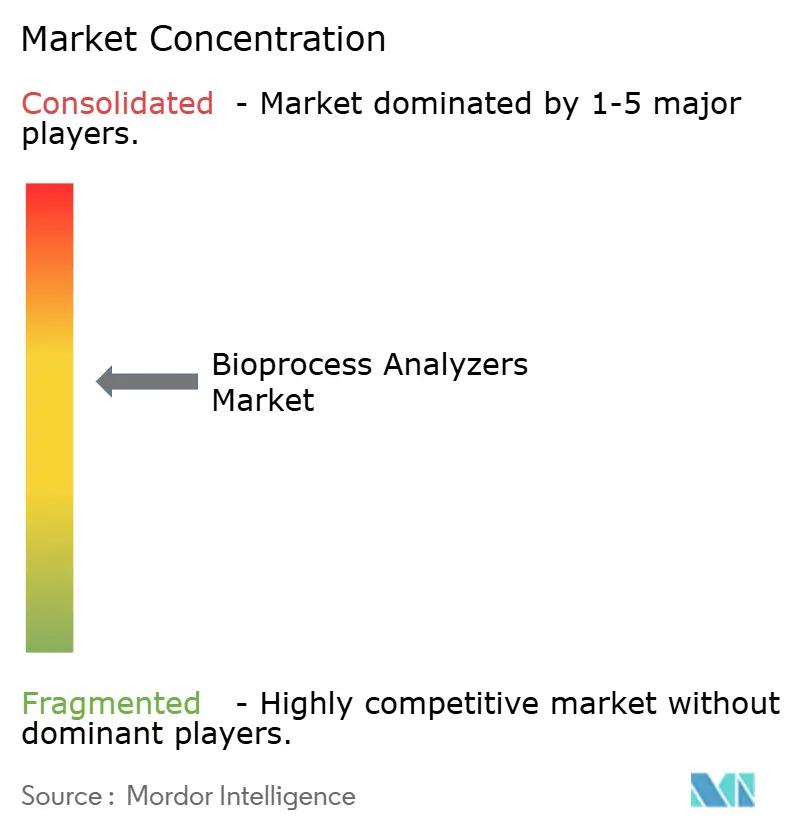
Recent Industry Developments
- June 2025: Waters Corporation debuted BioResolve Protein A columns with MaxPeak technology offering seven-fold sensitivity gains for antibody titer assays.
- May 2025: Agilent Technologies unveiled the next-generation InfinityLab LC portfolio with Assist automation for faster biopharma method deployment.
- April 2025: Beckman Coulter Life Sciences released the OptiMATE Gradient Maker, cutting ultracentrifugation workflows from three days to six hours.
- April 2025: Thermo Fisher Scientific introduced the 5 L DynaDrive single-use bioreactor, reporting a 27% productivity boost versus legacy glass systems.
- March 2025: Beckman Coulter Life Sciences launched the CytoFLEX mosaic Spectral Detection Module, the first modular spectral flow cytometer featuring up to 88 channels and detection down to 80 nm.
- January 2025: Advanced Instruments announced acquisition of Nova Biomedical to create a global life-science tools platform generating USD 621 million in combined sales, focusing on analytical instruments, reagents, and services for drug development and bioprocessing.
Global Bioprocess Analyzers Market Report Scope
As per the scope of the report, bioprocess is a technique used to produce biological products, such as microbial genetic strain, and commercially useful chemicals through a biological process.
The bioprocess analyzers market is segmented by product (instruments and consumables), application (antibiotics, recombinant proteins, biosimilars, and other applications), type (substrate analysis, metabolite analysis, and concentration detection), and geography (North America, Europe, Asia-Pacific, Middle East and Africa, and South America). The market report also covers the estimated market sizes and trends for 17 different countries across the major regions globally. The report offers the values (USD million) for the above segments.
| Instruments |
| Consumables |
| Software & Analytics |
| Raman Spectroscopy |
| Near-Infrared (NIR) |
| Mass Spectrometry |
| Electrochemical Sensors |
| Substrate Analysis |
| Metabolite Analysis |
| Concentration Detection |
| Physicochemical Parameter Monitoring |
| Vaccines |
| Antibiotics |
| Recombinant Proteins |
| Biosimilars |
| Other Applications |
| Biopharmaceutical & Pharmaceutical Companies |
| Contract Manufacturing/Research Organizations |
| Academic & Research Institutes |
| Other End-Users |
| North America | United States |
| Canada | |
| Mexico | |
| Europe | Germany |
| United Kingdom | |
| France | |
| Italy | |
| Spain | |
| Rest of Europe | |
| Asia-Pacific | China |
| Japan | |
| India | |
| Australia | |
| South Korea | |
| Rest of Asia-Pacific | |
| Middle East & Africa | GCC |
| South Africa | |
| Rest of Middle East & Africa | |
| South America | Brazil |
| Argentina | |
| Rest of South America |
| By Product | Instruments | |
| Consumables | ||
| Software & Analytics | ||
| By Measurement Principle | Raman Spectroscopy | |
| Near-Infrared (NIR) | ||
| Mass Spectrometry | ||
| Electrochemical Sensors | ||
| By Type | Substrate Analysis | |
| Metabolite Analysis | ||
| Concentration Detection | ||
| Physicochemical Parameter Monitoring | ||
| By Application | Vaccines | |
| Antibiotics | ||
| Recombinant Proteins | ||
| Biosimilars | ||
| Other Applications | ||
| By End-User | Biopharmaceutical & Pharmaceutical Companies | |
| Contract Manufacturing/Research Organizations | ||
| Academic & Research Institutes | ||
| Other End-Users | ||
| Geography | North America | United States |
| Canada | ||
| Mexico | ||
| Europe | Germany | |
| United Kingdom | ||
| France | ||
| Italy | ||
| Spain | ||
| Rest of Europe | ||
| Asia-Pacific | China | |
| Japan | ||
| India | ||
| Australia | ||
| South Korea | ||
| Rest of Asia-Pacific | ||
| Middle East & Africa | GCC | |
| South Africa | ||
| Rest of Middle East & Africa | ||
| South America | Brazil | |
| Argentina | ||
| Rest of South America | ||
Key Questions Answered in the Report
What is the current bioprocess analyzers market size?
The bioprocess analyzers market size reached USD 2.32 billion in 2025 and is projected to climb to USD 4.82 billion by 2030.
What CAGR is expected for the bioprocess analyzers market through 2030?
The market is forecast to grow at a robust 15.81% CAGR from 2025 to 2030.
Which product segment leads the bioprocess analyzers market?
Instruments dominate, accounting for 58.54% of 2024 revenue, though software and analytics are the fastest-growing category.
Which region is growing fastest in the bioprocess analyzers market?
Asia-Pacific is expected to post a 16.54% CAGR through 2030, outpacing all other regions.
Why are biosimilars important for future demand?
Biosimilars require intricate analytical proof of similarity, pushing demand for high-resolution, multi-attribute analyzers and driving an 18.99% CAGR in this application segment.
How are contract manufacturers influencing market dynamics?
Contract manufacturing organizations are scaling capacity rapidly, adopting standardized analytical platforms at an 18.67% CAGR, and thereby expanding the customer base for instrument and software vendors.
Page last updated on:
